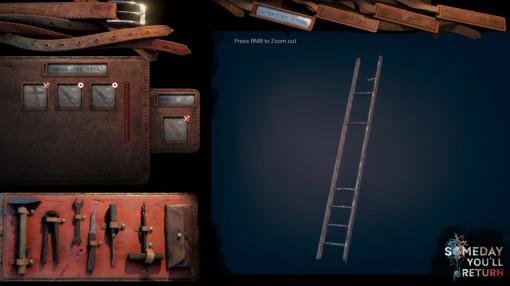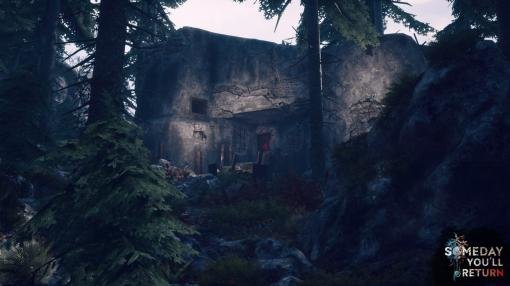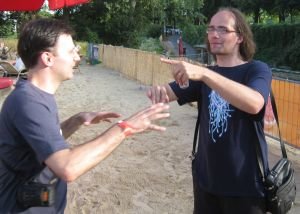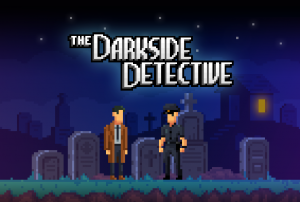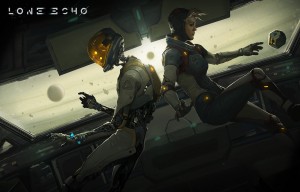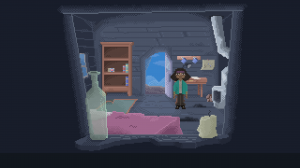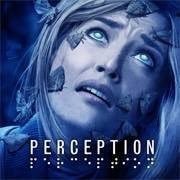Jan Kavan – Someday You’ll Return interview - page 2
If you have been following the social media channels of CBE Software throughout the last few years, you have probably noticed that the two-man team best known for its innovative sci-fi adventure J.U.L.I.A.: Among the Stars has been working on a new project for quite some time. Having previously teased the title but not much else, today the indie Czech development studio officially unveils its new psychological survival thriller. Eager to learn even more about the game, I caught up with CBE co-founder Jan Kavan to dig a little deeper. Read on as Jan takes us to the dark and mysterious woods of Moravia and shares some juicy details about Someday You’ll Return, which is currently slated for release in 2019.
Ingmar Böke: Hello Jan, it’s a pleasure to welcome you back to Adventure Gamers to discuss your new project Someday You’ll Return. Our last interview with you took place in March 2013, back when you were working on the enhanced edition of J.U.L.I.A. Please fill us in on what’s been happening between the release of that game and today's announcement of Someday You’ll Return.
Jan Kavan: Hi Ingmar, it’s always a pleasure to answer your questions so thank you for inviting me back here!
When we launched J.U.L.I.A.: Among the Stars, many things kept us busy. We had to finalize the physical rewards for our amazing backers and prepare a fully localized German version, just to name a couple of things.
When the dust settled, we slowly started to think about what to do next. At that time the Unreal Engine 4 came out and we did some experimentation with it, which turned into an immediate love of the technology. As it happens with us, we just wanted to do a small game, which would allow us to rest a bit from the exhausting J.U.L.I.A. production. It turned out that we gave birth to an incredibly monstrous project, especially considering our core two-man team.
We’ve been lucky though, because during our development we applied for funding from Creative Europe Programme by MEDIA of the European Union. We were selected and the money involved helped us to seriously raise the quality bar of the game.
In previous years we’ve hinted here and there that we are working on a game and even, albeit not entirely officially, released a short teaser video featuring a Moravian folk song. Then we disappeared again and worked for years until we felt that we are ready for the real announcement. That time is now!
Ingmar: Please tell us something about the premise and concept of Someday You’ll Return.
Jan: Someday You’ll Return is a present day psychological horror game, where you assume role of Daniel, who arrives deep in the woods to search for his missing daughter. It’s obvious from the start that she didn’t just get lost, but she actually keeps running away for some reason. This time it’s different, though. She ran away to a place Daniel swore he would never return. It’s up to players to find out why.
Daniel enters the forest by his car and is convinced that his smartphone tracker will make this ordeal just a short errand. As the game progresses, things obviously get complicated and he is forced to exchange modern technology for tools of his childhood as he is confronted with things he kept running from.
Ingmar: When I first read about your new game, I remembered something you told me at gamescom many years back. Back then, we were discussing our individual experiences when playing Quantic Dream’s Heavy Rain. You told me about the strong effect the game’s premise had on you as a father. So I can imagine that the creation of Someday You’ll Return must be quite intense for you on a personal level, too. Is the idea behind this something along the lines of, “I’ll take my strongest fears, and turn them into a game?”
 |
CBE co-founders Lukáš Medek (left) and Jan Kavan relax after a busy day at gamescom |
Jan: That’s a great deduction. It’s indeed one of the core aspects driving the story: not only the horrors of what could happen to my kids, but also the fear how much, as a father, I can fail.
Speaking of horrors, the game relies deeply on symbolism, so you are not going to encounter just random scary or weird things. Everything has a deep meaning in the context of the story and the world.
Ingmar: Let’s talk more about the different gameplay elements involved.
Jan: As you might know, we always try to incorporate something new into our gameplay mechanics. In the case of Someday You’ll Return, we are adding quite a few novelties. First of all, we are using a specialized workbench interface for inventory and world item manipulation, which I call Inventory 2.0.
Take your standard adventure game: you grab a cat, combine her with a smartphone and voila! You have a spy device.
In our game, you have to actually find a way how to make that happen. You can turn and examine individual items, interact with individual hotspots within them. You also don’t only combine items, but also incorporate various tools (hammer with nails, pliers, wrench, screwdriver, knife or hand drill) to achieve your goals. Your actions are immediately visible, so for me it feels way more interactive.
You'll need to get your hands dirty with some old-fashioned workbench tools to survive in Someday You'll Return
We also have herbalism. You gather herbs and mushrooms to create potions according to an old (fictional, don’t try this at home) book. This also involves using the correct parts of the plants in the right order.
There is a karmic system. The way you play and the actions you do have a consequence in the grand scheme of the game. This won’t be immediately visible but players will eventually find out.
You are going to climb, having to find your way through the rocky terrain, you have a smartphone at your disposal, you can track footprints and sometimes you have to sneak.
You can’t fight back the horrors, so there’s no combat involved.
Ingmar: The game features a semi-open world. Please tell us more about this approach, and the aspect of non-linearity in Someday You’ll Return.
Jan: The beginning part is fairly linear, but even there, if you explore, you can go off the path to discover secrets. Then, as you become more knowledgeable of the surroundings, it opens and you can go various places as you see fit.
Ingmar: Please tell me more about the survival element.
Jan: Daniel can’t fight, so he has to find creative ways to overcome everything the forest keeps throwing at him. He can craft items using the aforementioned workbench interface, and he will need herbalism to survive. There are traps and progressively nasty things so he has to be very careful and cautious where to step. Sometimes he just has to simply run away from danger.
There is no need to “drink or eat” in the context of survival, so for the vast majority of the game, players have all the time in the world to explore without feeling stressed that their food or time will run out.
Ingmar: Is the change between day and night-time going to have an impact on gameplay?
Jan: When night falls, apart from the fact that darkness can be more scary and disorienting, you need light to actually see around, otherwise some of the items or points of interest might remain hidden.
Ingmar: As I’m impressed by the visuals of Someday You’ll Return, it would be interesting to learn more about how you’re bringing real-life locations to life, and what experiences you’ve had with the Unreal Engine 4 so far.
Jan: Unreal Engine 4 is an incredible piece of software engineering. It allows us to use technology we never thought we would be able to – from motion capture to complex materials and lighting, the visual fidelity and the performance is stunning. We hope that when we tackle the PS4 and Xbox One versions, it will once again help as much as it does with the Windows build.
The downside is that for such a huge game trying to use the most of the engine, the learning curve is very steep and obviously not meant for a single person to know and understand everything. I am really glad that I learned C++ when I was still a kid.
Ingmar: The game involves an aspect local folklore. Please give us an idea of what that entails.
Jan: That’s a great question. The locations in our game are ancient. When Saints Cyril and Methodius came to Great Moravia in the 9th century, they walked the same paths you will be walking in the game. There are legends that the relics of Pope Klement I are buried beneath one of the game locations.
For quite some time in a pre-production phase, I was collecting folk tales and urban legends from the region. Strange apparitions, forest attacking people, you name it… The important part is that even the reason why we selected and use these tales in the story has a meaning.
Some of the NPCs you meet will also feel more like characters from the local folklore, but let’s keep this a secret for now.
Evidence of local folktales abound in the scenic countryside of Someday You'll Return
Ingmar: Can you give us a very rough idea of the game length you’re aiming for?
Jan: Not too long. I would say around 10 hours will be needed to play through the story. Of course, if someone will dedicate their time to search for all the secrets, it will be quite a bit longer. I obviously don’t include pure ‘walkthrough followers’. I have no idea how long the game will take for them.
Ingmar: Your homepage mentions an estimated release date in 2019. What’s the current production and funding status?
Jan: We are sailing full speed ahead. At this point we don’t plan any crowdfunding campaign, if that’s why you ask. We just want to survive the development and let people enjoy the game.
Ingmar: Are you planning to work with a publisher at some point or are you planning to self-publish the game?
Jan: At this point, this is an open question, but there is no publisher so far.
Ingmar: What games do you consider an influence for Someday You’ll Return?
Jan: We have several titles which helped us form what we want to do. Namely Silent Hill 2 for the reasons of how it works with symbolism and meanings; there is of course Firewatch and The Vanishing of Ethan Carter, because everyone seeing our game immediately gets a similar vibe. In our case we try to be more ‘interactive’ though. Outlast 2 and Resident Evil 7 helped us shape some dark aspects of the game.
Ingmar: Generally speaking, what games of the recent past have particularly impressed you because of their storytelling?
Jan: If there is one recent game which totally got me, it’s Kentucky Route Zero. The way the narrative unfolds and how your decisions subtly color the plot, instead of going down the pit of meaningless choices, really resonated with me. I practically don’t have time to play these days, but I know that when the last chapter comes out, I will play it right away.
This game was also basically one of the reasons we ditched the branching dialogues from Someday You’ll Return. We are unable to create meaningful consequences for each branch and the older I get, the more I see through many dialogue trees as an artificial hindrance to hide the right choice and thus delay player progression. Of course there are some exceptions, especially in non-adventure genres (Witcher 3 comes to mind).
And then … there’s Detroit: Become Human. I will be surely playing that game exactly for the reason of meaningful branching choices.
Ingmar: Jan, it’s been a pleasure once more. I hope that we’re going to be able to have a closer look at Someday You’ll Return at this year’s gamescom. Thanks much for your time!
Jan: Thank you so much, Ingmar! I can’t promise gamescom 2018 just yet. We’ve spent quite a lot of time at various conferences and we simply have to develop the game, but there are some things in motion now and I wouldn’t entirely rule out that possibility.


